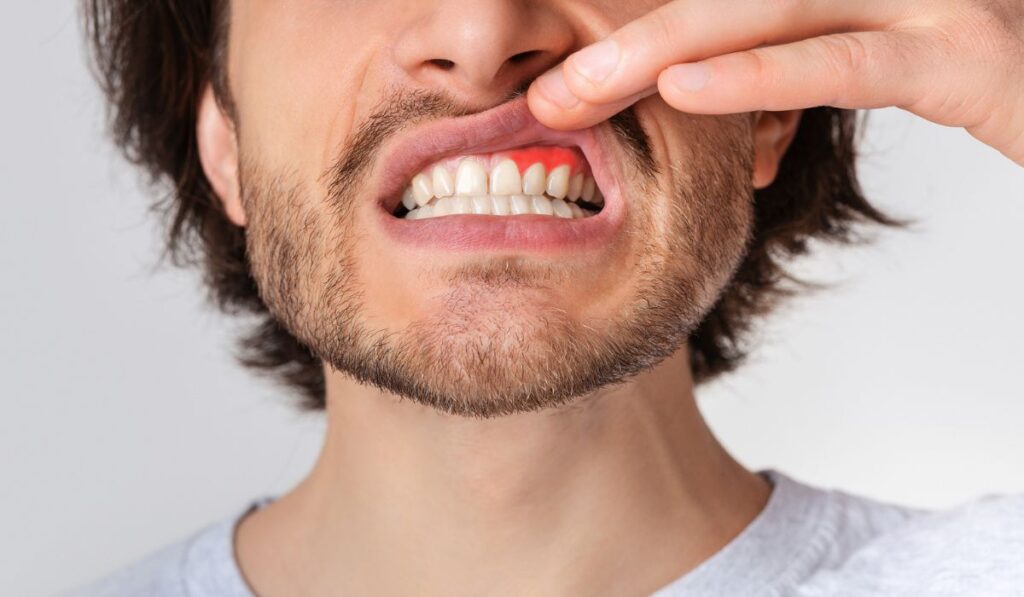Gum pain can make it difficult to eat and go about your daily life. The first step to solving gum pain is to find the root cause of the problem. But once you discover the problem, how do you resolve the pain?
Sore gums can be caused by gum disease, cankers, the use of tobacco, hormonal changes, an abscessed tooth, or oral cancer. Always go to the dentist if you have pain that doesn’t go away. However, there are a few things you can do at home, like salt water rinses and hydrogen peroxide mouthwash.
Gum pain is the worst, and hard to pin point because it could easily be the tooth that hurts as well. Let’s look at more information on how you can find the root of your gum pain and what you can do to resolve it.
Why Do Your Gums Hurt?

There are several reasons why your gums could be hurting, and knowing the reason behind the pain is the first step in correcting the issue.
Gum Disease
Gum disease happens more often than people realize. It can occur from not brushing properly or forgetting that flossing is equally important as brushing your teeth. From aggressive brushing to infrequent brushing, knowing how to properly care for your oral hygiene is vitally important to maintaining a healthy mouth.
The first signs that you have gum disease are bleeding, swelling and redness at the gum line. At this early stage there might not even be pain yet.
So if these few signs are ignored and you continue to brush too aggressively, not frequently enough or even forget to floss, then matters can only get worse and could lead to periodontitis, a more serious case of infection.
Gum disease has also been linked to heart disease, so it is important to keep your mouth healthy.
If left untreated your gums will begin to pull away from the root, which is the reason for the pain. The purpose of gums is to protect the sensitive roots of your teeth and when those are exposed, they begin to send signals to your brain that they are in pain.
On top of the exposed root, the gums that have been pulled away from your teeth create little pockets that collect tiny particles of food and eventually cause infection. This can ultimately cause the tooth to loosen or the bone that holds them in place to break down and lead to tooth loss.
Canker Sores
Cankers are common ailments that affect almost everyone. They can appear anywhere in the mouth, including on the gums, and can show up as red splotches. However, they could also have a white coating to them.
Canker sores can form due to a variety of reasons, including braces. There is no treatment, but they tend to go away within a week or two on their own. If it’s been two weeks and are still present and sore, then it would be time to book an appointment with your dentist.
Tobacco Intake
If you smoke or ingest smokeless products that use tobacco, such as chewing tobacco, dip or snuff, then you are at a greater risk of developing gum disease. Smokeless tobacco is usually placed between the cheek and gum, which can cause more damage to your mouth than smoking cigarettes can.
Your gums also have a greater possibility of pulling away from your teeth, and the usage of smokeless products can cause sores to form on the inside of your mouth and around your gums. This could also lead to a greater chance of getting oral cancer.
Hormonal Changes
For women, hormones can affect your gums as you go through different life stages. During puberty, more blood flows to your gums and they can end up feeling swollen, tender or even painful. During your period, you might also have these same symptoms.
If you happen to be pregnant, your shifting hormone levels can surge and affect your gums. During this time, it is important to contact your doctor if your gums have started to bleed or hurt.
Finally, once you hit menopause, your hormone levels shift again and tend to fall, resulting in bleeding gums, color changes, burning sensations and even pain in your mouth.
Abscessed Tooth
When an infection has taken root in your tooth, it forms a pocket that collects bacteria and generates pus known as an abscess. They don’t always hurt but most of them do, and they almost always cause the surrounding gums to swell. If you notice your gums are swollen and tender, talk to your dentist.
Oral Cancer
Oral cancer can start anywhere in your mouth, from your tongue, cheeks, tonsils or gums. It can start in the form of a sore in your mouth that doesn’t heal, and it might not even be painful at the beginning.
Always keep an eye on any sores in your mouth and if you suspect something might be wrong, or it doesn’t heal in a couple of weeks, pay a visit to your dentist.
How to Relieve Gum Pain
If your gums are aching and you’ve determined it’s nothing that warrants a visit to the dentist, then there are a few things you can do at home to help relieve gum pain until the ailment heals.
- Rinse your mouth out twice a day with warm salt water for 30 seconds each time.
- Switch your toothbrush to a soft or extra soft bristle brush.
- Pay close attention to how you are brushing. You want to do so softly and in circular motions while moving away from your gums. Ideally, brush for two minutes twice a day.
- Floss at least once a day.
- Over the counter painkillers, such as Tylenol, can help temporarily relieve pain.
- Purchase a mouthwash containing hydrogen peroxide and follow the instructions provided on the package.
- You could use a gel such as Anbesol that is applied directly to your gums to help alleviate the pain.
- If your gums hurt with a white coating on your tongue then you have thrush, a type of yeast infection. Eating live culture yogurt can help but you will need to see a doctor or dentist.
- Avoid spicy, salty or acidic foods as they can aggravate already sore gums.
When Should You See a Dentist for Gum Pain?

Knowing when to see a dentist is important so your gum pain doesn’t increase or lead to serious problems.
If you see red, swollen gums that bleed easily, that is a sign you have a gum disease called gingivitis. It’s important to see a dentist with these specific signs in order to get proper treatment, as untreated gingivitis can lead to periodontitis. A condition that forms painful abscesses in your gums.
Contact your dentist if you see any of these other symptoms:
- Bleeding gums.
- Red and swollen gums.
- Ongoing pain that doesn’t go away, or gets worse after a couple weeks.
- Sores that don’t heal after a couple of weeks.
- Gums that have pulled back from your teeth.
- Dentures don’t fit correctly anymore.
- Pain when you chew.
- Adult teeth are loose.
- Ongoing or severe tooth sensitivity to hot or cold temperatures.
